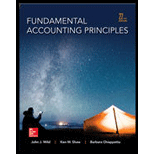
Concept Introduction:
Forms of the Business Organizations:
A business can be formed into any of the business organization types like,
• Partnership: Partnership is one of the types of business origination. Under the partnership, two or more individuals agree to form a business together and share losses and profits in the predetermined ratio.
• Corporate form: Corporate form is the most complicated and wider form of business organization. It creates a separate legal identity of the business and allows the business to raise funds through public issue.
• Sole proprietorship: Amongst all of the business organization forms, a sole proprietorship is the simplest form. Under a sole proprietorship, the business is owned and controlled by a single person.
To determine: The form of business organization, tax liability and one advantage of the form of business organization for the owner for each of the given case.
Want to see the full answer?
Check out a sample textbook solution
Chapter 12 Solutions
Fundamental Accounting Principles -Hardcover
- I am trying to find the accurate solution to this general accounting problem with appropriate explanations.arrow_forwardI need help with this general accounting question using standard accounting techniques.arrow_forwardI am looking for a reliable way to solve this financial accounting problem using accurate principles.arrow_forward
- I need help with this general accounting problem using proper accounting guidelines.arrow_forwardPlease explain the solution to this general accounting problem using the correct accounting principles.arrow_forwardCan you help me solve this general accounting question using the correct accounting procedures?arrow_forward
- Horngren's Financial & Managerial Accounting: The Managerial Chapters, 8th Edition. E-M:9-14 Describing the balanced scorecard and identifying key performance indicators for each perspectiveConsider the following key performance indicators and classify each indicator according to the balanced scorecard perspective it addresses. Choose from the financial perspective, customer perspective, internal business perspective, and the learning and growth perspective. a.Number of customer complaintsb.Number of information system upgrades completedc.Residual incomed.New product development timee.Employee turnover ratef.Percentage of products with online help manualsg.Customer retentionh.Percentage of compensation based on performancei.Percentage of orders filled each weekj.Gross margin growthk.Number of new patentsl.Employee satisfaction ratingsm.Manufacturing cycle time (average length of production process)n.Earnings growtho.Average machine setup timep.Number of new customersq.Employee…arrow_forwardDo fast answer of this general accounting questionarrow_forwardPlease provide the solution to this general accounting question with accurate accounting calculations.arrow_forward

 AccountingAccountingISBN:9781337272094Author:WARREN, Carl S., Reeve, James M., Duchac, Jonathan E.Publisher:Cengage Learning,
AccountingAccountingISBN:9781337272094Author:WARREN, Carl S., Reeve, James M., Duchac, Jonathan E.Publisher:Cengage Learning, Accounting Information SystemsAccountingISBN:9781337619202Author:Hall, James A.Publisher:Cengage Learning,
Accounting Information SystemsAccountingISBN:9781337619202Author:Hall, James A.Publisher:Cengage Learning, Horngren's Cost Accounting: A Managerial Emphasis...AccountingISBN:9780134475585Author:Srikant M. Datar, Madhav V. RajanPublisher:PEARSON
Horngren's Cost Accounting: A Managerial Emphasis...AccountingISBN:9780134475585Author:Srikant M. Datar, Madhav V. RajanPublisher:PEARSON Intermediate AccountingAccountingISBN:9781259722660Author:J. David Spiceland, Mark W. Nelson, Wayne M ThomasPublisher:McGraw-Hill Education
Intermediate AccountingAccountingISBN:9781259722660Author:J. David Spiceland, Mark W. Nelson, Wayne M ThomasPublisher:McGraw-Hill Education Financial and Managerial AccountingAccountingISBN:9781259726705Author:John J Wild, Ken W. Shaw, Barbara Chiappetta Fundamental Accounting PrinciplesPublisher:McGraw-Hill Education
Financial and Managerial AccountingAccountingISBN:9781259726705Author:John J Wild, Ken W. Shaw, Barbara Chiappetta Fundamental Accounting PrinciplesPublisher:McGraw-Hill Education





